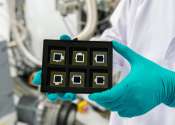New iron catalyst could make hydrogen fuel cells affordable
For decades, scientists have been searching for a catalyst that dramatically reduces the cost of fabricating hydrogen fuel cells.
Jul 7, 2022
1
11820
Energy & Green Tech

For decades, scientists have been searching for a catalyst that dramatically reduces the cost of fabricating hydrogen fuel cells.
Jul 7, 2022
1
11820
Electronics & Semiconductors

Thermoelectrics directly convert heat into electricity and power a wide array of items—from NASA's Perseverance rover currently exploring Mars to travel coolers that chill beverages.
Apr 16, 2021
0
747
Energy & Green Tech

Battery-powered vehicles have made a significant dent in the transportation market. But that market still needs lower cost batteries that can power vehicles for greater ranges. Also desirable are low-cost batteries able to ...
Mar 24, 2022
0
95
Electronics & Semiconductors

With more than 1,000 nerve endings, human skin is the brain's largest sensory connection to the outside world, providing a wealth of feedback through touch, temperature and pressure. While these complex features make skin ...
Jan 26, 2024
2
116
Energy & Green Tech

Scientists from the National University of Singapore (NUS) have developed a novel triple-junction perovskite/Si tandem solar cell that can achieve a certified world-record power conversion efficiency of 27.1% across a solar ...
Mar 5, 2024
0
32
Electronics & Semiconductors

The future's getting brighter for solar power. Researchers from CU Boulder have created a low-cost solar cell with one of the highest power-conversion efficiencies to date, by layering cells and using a unique combination ...
Mar 5, 2020
0
292
Hi Tech & Innovation

An experimental computing system physically modeled after the biological brain has "learned" to identify handwritten numbers with an overall accuracy of 93.4%. The key innovation in the experiment was a new training algorithm ...
Nov 14, 2023
0
397
Engineering

Researchers at Kyoto University's Institute for Cell-Material Sciences (iCeMS) have developed a new approach to speed up hydrogen atoms moving through a crystal lattice structure at lower temperatures. They reported their ...
Jun 2, 2021
0
16
Energy & Green Tech

A plentiful supply of clean energy is lurking in plain sight. It is the hydrogen we can extract from water (H2O) using renewable energy. Scientists are seeking low-cost methods for producing clean hydrogen from water to replace ...
May 30, 2023
0
50
Electronics & Semiconductors

Nonlinear optics is a research field that explores how intense light interacts with matter. Typically, the optical response of materials is linearly associated with the amplitude of the electric field applied to them. At ...
The atom is a basic unit of matter consisting of a dense, central nucleus surrounded by a cloud of negatively charged electrons. The atomic nucleus contains a mix of positively charged protons and electrically neutral neutrons (except in the case of hydrogen-1, which is the only stable nuclide with no neutron). The electrons of an atom are bound to the nucleus by the electromagnetic force. Likewise, a group of atoms can remain bound to each other, forming a molecule. An atom containing an equal number of protons and electrons is electrically neutral, otherwise it has a positive or negative charge and is an ion. An atom is classified according to the number of protons and neutrons in its nucleus: the number of protons determines the chemical element, and the number of neutrons determine the isotope of the element.
The name atom comes from the Greek ἄτομος/átomos, α-τεμνω, which means uncuttable, something that cannot be divided further. The concept of an atom as an indivisible component of matter was first proposed by early Indian and Greek philosophers. In the 17th and 18th centuries, chemists provided a physical basis for this idea by showing that certain substances could not be further broken down by chemical methods. During the late 19th and early 20th centuries, physicists discovered subatomic components and structure inside the atom, thereby demonstrating that the 'atom' was divisible. The principles of quantum mechanics were used to successfully model the atom.
Relative to everyday experience, atoms are minuscule objects with proportionately tiny masses. Atoms can only be observed individually using special instruments such as the scanning tunneling microscope. Over 99.9% of an atom's mass is concentrated in the nucleus, with protons and neutrons having roughly equal mass. Each element has at least one isotope with unstable nuclei that can undergo radioactive decay. This can result in a transmutation that changes the number of protons or neutrons in a nucleus. Electrons that are bound to atoms possess a set of stable energy levels, or orbitals, and can undergo transitions between them by absorbing or emitting photons that match the energy differences between the levels. The electrons determine the chemical properties of an element, and strongly influence an atom's magnetic properties.
This text uses material from Wikipedia, licensed under CC BY-SA